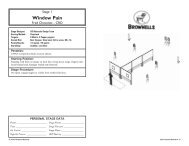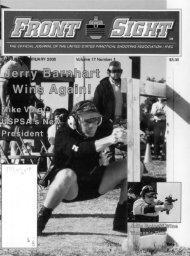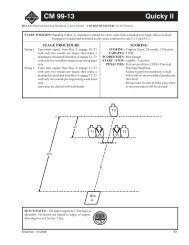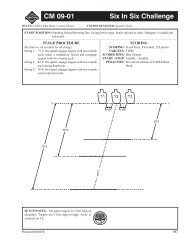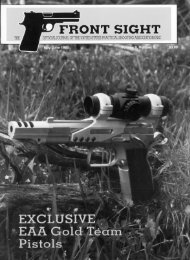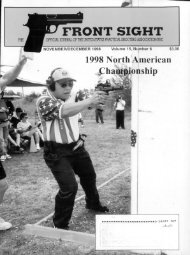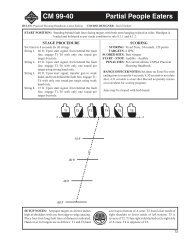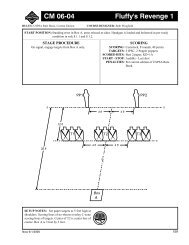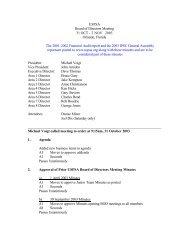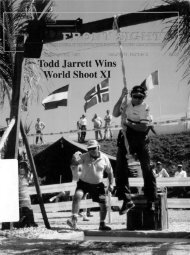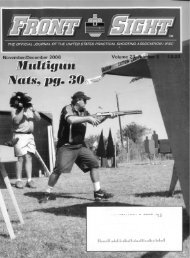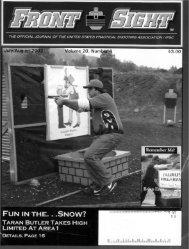You also want an ePaper? Increase the reach of your titles
YUMPU automatically turns print PDFs into web optimized ePapers that Google loves.
Exercise 2: Here is an exercise that<br />
will increase your speed of visual acquisition<br />
of the sights on target and<br />
from target to target.<br />
Point your finger at an object. Now,<br />
without changing the orientation of<br />
your hand, lower your hand back to<br />
your natural handclap position where<br />
your hands would come together when<br />
you clap. Keeping your finger level<br />
with where you were looking, bring<br />
your finger back up and stick the end<br />
of the finger straight into the object<br />
you are looking at.<br />
Now, put your gun in your hands<br />
and bring your gun up to the target and<br />
properly align the sights. Without<br />
changing the orientation of your hands<br />
or wrists, slowly lower the gun to your<br />
"natural handclap" position where you<br />
would normally clap your hands together.<br />
Keep your trigger finger, which is<br />
alongside the frame, level with where<br />
you are looking. Bring the gun back up,<br />
using your kinesthetic awareness to<br />
feel the slide coming up level with<br />
where you are looking.<br />
Start doing this at different levels:<br />
knee high, waist high, head high; each<br />
time, bringing the gun up level with<br />
where you are looking.<br />
In both of these exercises, you are<br />
developing kinesthetic awareness of<br />
the attitude of the gun as you are lifting<br />
it to eye level. This allows your<br />
brain to recognize a properly aligned<br />
gun prior to it getting to the visual<br />
field. Your vision will confirm the<br />
alignment, which should be close to<br />
perfect when it got there.<br />
Now try doing this from the holster.<br />
Now do it with eyes closed. Now,<br />
move the gun from target to target,<br />
feeling it staying level for your eyes as<br />
you move it. See it pause on each target<br />
and confirm sight alignment before<br />
you move on. As you move the gun,<br />
monitor the tension in your solar<br />
plexus and midsection and try to keep<br />
that area relaxed as you move.<br />
The concept here is that the body<br />
points and the eyes verify. Kinesthetic<br />
and visual skills work together for<br />
maximum efficiency. Pay attention to<br />
what is happening in your body as you<br />
are executing your skills.<br />
Obviously this is just a preliminary<br />
discussion of training for skills improvement.<br />
There is a whole range of<br />
training that I do to prepare students to<br />
maximize their performance in the environments<br />
they operate in, both tacti-<br />
FEED<br />
TUBE continued from page 71.<br />
ing the shell carrier closer to his body.)<br />
The downside to the system appears<br />
in weight and fragility. DeSimone's<br />
suspended tube has some obvious<br />
problems with fragility, but Roessel's<br />
system is protected and supported<br />
by the barrel and magazine (see photos).<br />
DeSimone has nearly perfected<br />
the shell stops — a major improvement<br />
over Roessel's friction system, so together<br />
the pair may soon develop a<br />
truly marketable design. Feed tubeequipped<br />
shotguns are heavy and slow<br />
from target to target, but the reloading<br />
speed bonus seems to make up for a lot<br />
of that.<br />
How heavy? You be the judge. On<br />
DeSimone's Open Division Remington<br />
1100, between the magazine (10), the<br />
feed tube (11), a sidesaddle (6), a<br />
forend side-saddle (5), and the round<br />
in the chamber (1), a shooter can leave<br />
the line with 33 rounds on the gun.<br />
Roessel's Remington 1100 feels less<br />
ambitious, but don't be fooled. It was<br />
built to suit a different drummer. It's<br />
smaller, lighter, and quicker, but carries<br />
the same 33 rounds. It sports a shorter<br />
cal and competitive, with whatever<br />
weapon systems they will be using. Scientific<br />
training methods allow one to<br />
maximize his or her training and take<br />
it to an entirely new level.<br />
Next time, we will explore the<br />
shooting cycle and how to use visual<br />
and kinesthetic skills together!<br />
-11<br />
barrel with Limited-legal magazine (8),<br />
a specially shaved-down Tac-Star<br />
sidesaddle (6), a second such sidesaddle<br />
on the butt (6), his gravity-fed feed<br />
tube (12). Add the round in the chamber<br />
(1) and you get a total of 33.<br />
Like the ugly pistols mentioned in<br />
Dave Dawson's column on page 51,<br />
Roessel's gun won't win any gunsmith<br />
guild awards. It's an ugly, Parkerized,<br />
3-inch 1100 that looks like it fell off a<br />
truck. Once you pick it up, you start<br />
noticing the oversize safety, the fiber<br />
optic rifle sights, the shaved sidesaddles<br />
(that allow shells to peel out sideways),<br />
the screw-in chokes, the<br />
hogged-out magazine tube opening. . .<br />
After having a chance to play with it for<br />
a short time, a whole lot of beauty<br />
started shining through.<br />
Will their innovation change the<br />
world of practical shotgunning? Who<br />
knows, it's not finished yet. I'm not expert<br />
enough to evaluate the extra<br />
weight out on the barrel, but I do know<br />
their system will force shooters to rethink<br />
how ammo carriers should work.<br />
6.91<br />
CIOSe-up of<br />
DeSimone's<br />
version. The<br />
space between<br />
the feed tube<br />
and the forend<br />
provides space<br />
for your hand.<br />
It's a little awkward,<br />
but it<br />
works.<br />
<strong>Jul</strong>y <strong>Aug</strong>ust 2002 • FRONT SIGHT 73



